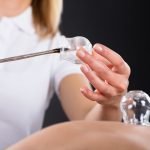Cristina Romero-Bosch, NMD
Tolle Totum
Female Sexual Dysfunction (FSD) negatively affects the overall quality of life of females, and may often be responsible for specific psychologic and physiologic disturbances. This condition not only adversely affects interpersonal relationships but also affects health.1,2 The purpose of this article is to provide an overview of guidelines for diagnosis so that FSD maybe better recognized, also to provide treatment suggestions that may help relieve the patient of this unnecessary ailment.
Female Sexual Dysfunction & Sexuality
Although FSD is increasingly recognized, it nonetheless continues to be significantly underdiagnosed. Prevalence of FSD in the developed world is estimated at 25-60% but only through surveys.3 Since these statistics are not reflective of actual diagnoses, they only convey how common this condition is, not how effectively it is being medically managed. This broad range may also suggest the difficulty both patient and physician have in recognizing a female sexual dysfunction. Adding to the challenge of proper diagnosis is patients either not being aware that they have a sexual dysfunction or feeling too uncomfortable or embarrassed to discuss their concerns with their health professional.4
To better understand the complex nature of FSD, it is important to define the condition and its diagnostic criteria, and to be familiar, in general, with the multi-factorial notion of sexuality.
Female sexual dysfunction is recognized as an official diagnosis despite its highly subjective nature. The ICD10 code of F52 is defined as “Sexual dysfunction that is not due to any known substance or physiologic condition.”5,6 However, this does not consider low levels of sex hormones as a physiologic condition.
FSD is further categorized, depending on the predominant complaint of the patient, into 4 types7:
- Low sexual desire: This is the most common form of FSD; it is also the most abstract, as it is defined by a lack of interest and lack of willingness for sexual interaction8,9
- Sexual arousal disorder: This is diagnosed when the person reports a desire for sex but has a pronounced difficulty with arousal
- Orgasmic disorder: This is diagnosed when the person wants to have sex, is able to be aroused, but then cannot reach orgasm. This difficulty with orgasm must be reported after the person confirms a desire for sex and an ability to feel sexually aroused.
- Sexual pain disorder: This is independent of desire and arousability. This presents in the person that has any pain associated with sexual stimulation or vaginal contact.
A reason for patients not knowing that they indeed suffer from FSD is the cultural lack of appreciation for female sexual satisfaction. Traditional culture has placed such emphasis on male orgasm over female orgasm that many women do not even realize this is an attainable option. A female’s relationship to a satisfying adult sex life (or lack thereof) stems from the formation of her sense of sexuality from childhood.10 Because an individual’s sexuality is at the core of this diagnosis, understanding sexuality can help to identify root causes of FSD in a patient.
Sexuality is defined as the state of being sexual, including engaging in sexual activity, sexual identity, and the expression of sexual interest. This multifaceted complex involves the individual’s physical, physiologic, and psychological self. It also involves the person’s culture, life experiences, beliefs, and values. In addition, sexuality varies with each relationship, revealing that a sense of intimacy is a significant influence on sexuality and, hence, female sexual dysfunction.11 Defining one’s sexuality is an ongoing process throughout an individual’s life.
Sexuality can be divided into 2 categories: 1) Sexual Identity (gender identity, sexual orientation, and sexual intention); and 2) Sexual Function (desire, arousal, orgasm).12 These components shape a person’s assessment of her sexual experiences and satisfaction.
With this preliminary understanding of sexuality and FSD, healthcare providers can begin to dissect the layers of FSD presenting in a patient, through open, non-judgmental discussion with the patient where together a detailed history of the symptoms, current relationship, and sexual satisfaction can be compiled that yields clues as to what treatment options might be most effective. The Female Sexual Function Index (fsfi) is a useful survey of symptoms that can be used to help guide the diagnosis and determine categories of primary concern.13
Causes of FSD
Appreciating the complexity of female sexual dysfunction will encourage the healthcare provider to be thorough in their evaluation. FSD can occur at any point during a female’s life and can be specific to a relationship, time-frame, or situation, or can be due to an ongoing state of disease. The first step in treating FSD is understanding to what extent the patient is inflicted.
The primary potential causes, to be determined through open discussion with the patient, are the following:
- Mental and Emotional Stress14: This broad category relates to everything from financial concerns to the health of loved ones. Obviously, a detailed history is vital here.
- Lack of Intimacy: Although this can be grouped under Mental and Emotional Stress, because this is the most common cause of sexual dysfunction in women, it should ideally be evaluated as its own category.15,16 It is important to keep in mind that, as the healthcare provider, you may be the first to identify FSD for the patient; she may not be aware that her disinterest in her sexuality is a condition that can and should be treated. An unwitting female may not realize that FSD might be causing additional health concerns such as anxiety, depression, or chronic inflammation from chronic stress. The treatments she may be using to address these ailments might also be exacerbating her FSD, thereby making both the FSD and the “side effect” ailment less likely to resolve.17
- Sex Hormone Deficiency: Situational transitions such as post-pregnancy or menopause can lead to FSD. Peri- and post-menopausal states are common causes of FSD, since lower testosterone and estrogen levels can result in decreased libido, genital dryness/atrophy, and other factors impacting sexual responsiveness and pleasure.18
- Medications: Technically, pharmaceutical agents such as anti-hypertensives and anti-depressants would be “a known cause” for FSD, and therefore do not accurately fulfill the ICD10 criteria for diagnosis. However, they are mentioned here as a reminder of causative agents that can be easily overlooked.19
- Chronic Inflammatory Conditions: An appropriate review of systems will help identify concomitant conditions that may be causing or exacerbating FSD. Is there a cardiovascular component preventing engorgement of the clitoris? Are there gastrointestinal complaints causing pain in the abdomen that makes penetration uncomfortable? Is there any localized trauma to the genitalia, eg, lichen sclerosis, causing pain during stimulation?
Treatment
Treatment recommendations must be as multi-factorial as the condition. Female sexual dysfunction perfectly fits into the philosophy and scope of naturopathic physicians, as they are specifically trained to encourage open discussion for the purpose of a detailed history. Naturopathic physicians are also skilled at identify the underlying causes of a patient’s symptoms by exploring all potentially involved systems, versus simply regarding FSD as a gynecologic or psychological condition. This is vital for the diagnosis and successful treatment of FSD, since it is a highly complex condition that is illuminated only when the patient can be guided into earnest disclosure.
Bioidentical HRT
The use of testosterone and/or estrogen, and replacement, when indicated, has been shown to positively enhance sexual function overall.20,21 Of course, progesterone should always accompany estrogen replacement in a woman with an intact uterus.
The “O”Shot
Platelet-Rich Plasma (PRP) injected into the vagina, clitoris, and surrounding genitalia can often enhance sexual pleasure as well as ease and quality of orgasm, both clitoral and internal.22
Lifestyle Modification
Factors such as smoking, excessive alcohol, and sedentary lifestyle have been shown to negatively affect sexual arousal.23,24
Mental/Emotional Therapy
Mental/Emotional therapy in varying forms, along with replacement of deficient hormones, often produces a successful outcome. An exploration of intimacy, the health of the patient’s current relationship, and the patient’s own view of sexuality are all vital components. In the case of a monogamous relationship, this detailed discussion can be even more effective when both partners are interviewed together as well as apart. Although therapy, specifically sex therapy, has been the primary treatment for FSD, it has been found to be ineffective at completely resolving the condition when used as the sole form of treatment.25 So, although M/E therapy is often helpful, consideration of these other factors is important.
Conventional Pharmaceuticals
Interventions such as sildenafil have been shown to improve clitoral sensitivity, but not found to improve sexual desire.26,27
Conclusion
It is the complexity and multi-factorial cascade of possible contributing factors that make female sexual dysfunction such an important health concern. Understanding the intricacies of sexuality will enable healthcare practitioners to successfully identify and correct this condition. A multi-pronged approach is the most efficient way to treat FSD. Therefore, remaining well grounded in the principles of treating the cause and treating the whole person will ensure that female patients achieve a more satisfying and healthier sexual identity and expression.
Refs:
- Frank E, Anderson C, Rubinstein D. Frequency of sexual dysfunction in “normal” couples. N Engl J Med.1978;299(3):111-115.
- Schnarch D. Intimacy & Desire: Awaken the Passion in Your Relationship. New York, NY: Beaufort Books; 2011.
- Aschkenazi SO, Goldberg RP. Female Sexual Function and the Pelvic Floor. Expert Rev Obstet Gynecol. 2009;4(2):165-178.
- Mercer CH, Fenton KA, Johnson AM, et al. Sexual function problems and help seeking behaviour in Britain: national probability sample survey. BMJ.2003;327(7412):426-427.
- com. The Web’s Free 2017/18 ICD-10-CM/PCS Medical Coding Reference. Available at: http://www.icd10data.com/. Accessed September 1, 2017.
- Shifren JL, Johannes CB, Monz BU, et al. Help-seeking behavior of womenwith self-reported distressing sexual problems. J Womens Health (Larchmt). 2009;18(4):461-468.
- Derogatis LR, Rosen R, Leiblum S, et al. The Female Sexual Distress Scale (FSDS): initial validation of a standardized scale for assessment of sexually related personal distress in women. J Sex Marital Ther. 2002;28(4):317-330.
- Simons JS, Carey MP. Prevalence of sexual dysfunctions: results from a decade of research. Arch Sex Behav. 2001;30(2):177-219.
- McCabe MP, Sharlip ID, Lewis R, et al. Incidence and Prevalence of Sexual Dysfunction in Womenand Men: A Consensus Statement from the Fourth International Consultation on Sexual Medicine 2015. J Sex Med. 2016;13(2):144-152.
- Bancroft J. Human Sexuality and its Problems. 3rd ed. London, England: Churchill Livingstone; 2009.
- Maxwell JA, Muse A, MacDonald G, et al. How implicit theories of sexuality shape sexual and relationship well-being. J Pers Soc Psychol.2017;112(2):238-279.
- Montgomery KA. Sexual desire disorders. Psychiatry (Edgmont). 2008;5(6):50-55.
- Female Sexual Function Index (FSFI). Available at: www.fsfiquestionnaire.com. Accessed September 1, 2017.
- Goliszek A. The Stress-Sex Connection: How to prevent stress from ruining your sex life. December 22, 2014. Psychology Today. Available at: https://www.psychologytoday.com/blog/how-the-mind-heals-the-body/201412/the-stress-sex-connection. Accessed September 1, 2017.
- Whipple B. Women’s Sexual Pleasure and Satisfaction. A New View of Female Sexual Function. The Female Patient. 2002;27:39-44.
- Leiblum SR, ed. Principles and Practice of Sex Therapy. 4th ed. Unknown publisher; 2006.
- Safarinejad MR. Female sexual dysfunction in a population-based study in Iran: prevalence and associated risk factors. Int J Impot Res. 2006;18(4):382-395.
- Ambler DR,, Bieber EJ, Diamond MP. Sexual function in elderly women: a review of current literature. Rev Obstet Gynecol. 2012;5(1):16-27.
- Crenshaw TL, Goldberg JP. Sexual Pharmacology: Drugs That Affect Sexual Function.New York, NY: WW Norton & Company; 1996.
- Berman JR, Berman LA, Werbin TJ, et al. Clinical evaluation of female sexual function: effects of age and estrogen status on subjective and physiologic sexual responses. Int J Impot Res. 1999;11 Suppl 1:S31-S38.
- Sarrel P, Dobay B, Wiita B. Estrogen and estrogen-androgen replacement in postmenopausal women dissatisfied with estrogen-only therapy. Sexual behavior and neuroendocrine responses. J Reprod Med.1998;43(10):847-856.
- Runels C. Activate the Female Orgasm System: The Story of O-Shot. Amazon Digital Services LLC; 2013.
- Cayan S, Akbay M, Bozlu B, et al. Prevalence of female sexual dysfunction and potential risk factors that may impair sexual function in Turkish women. Urol Int. 2002;72(1):52-57.
- Lewis RW, Fugl-Meyer KS, Corona G, et al. Epidemiology/risk factors of sexual dysfunction. J Sex Med. 2004;1(1):35-39.
- Allahdadi KJ, Tostes RC, Webb RC. Female sexual dysfunction: therapeutic options and experimental challenges. Cardiovasc Hematol Agents Med Chem. 2009;7(4):260-269.
- Nurnberg HG, Hensley PL, Heiman JR, et al. Sildenafil treatment of women with antidepressant-associated sexual dysfunction: a randomized controlled trial. JAMA. 2008;300(4):395-404.
- Kaplan SA, Reis RB, Kohn IJ, et al. Safety and efficacy of sildenafil in postmenopausal women with sexual dysfunction. Urology. 1999;53(3): 481-486.
Image Copyright: <a href=’https://www.123rf.com/profile_olegdudko’>olegdudko / 123RF Stock Photo</a>
 Cristina Romero-Bosch, NMD, and John A. Robinson, NMD, have been practicing medicine since 2006. They bring their passion for healthy living and graceful aging to their patients every day at The Hormone Zone, their cutting-edge medical practice, located in Scottsdale, AZ. Visit www.hormone-zone.com for more info.
Cristina Romero-Bosch, NMD, and John A. Robinson, NMD, have been practicing medicine since 2006. They bring their passion for healthy living and graceful aging to their patients every day at The Hormone Zone, their cutting-edge medical practice, located in Scottsdale, AZ. Visit www.hormone-zone.com for more info.





